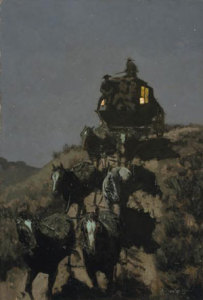
“The Old Stage Coach of the Plains,” painted by Frederic S. Remington, can be seen at the Amon Carter Museum, Fort Worth, Texas.
When I was in elementary school in Jacksboro, my parents took my brother and me to the steps of the First Presbyterian Church to watch the Stage Coach come through town. Since he and I were avid Lone Ranger fans, we thought this was special. In case you wonder, Jacksboro had and still has a population of about 4,000 souls. A stagecoach coming down the street was about as exciting as things got around there.
Earlier this fall, I went back to Jacksboro to do oral history interviews with some old cowboys and ranchers. As we drove through the ranch we saw what looked like a sunken road for about 100 yards. Having never given it much thought about how the stagecoach appeared on Main Street, I suddenly realized this was part of the Butterfield Overland Mail Trail from Memphis to San Francisco by way of San Diego.
The Butterfield Overland Mail Trail was authorized by the US government on March 3, 1857 to meet the need for better communication between the East Coast and California. At that time, the stagecoach was the most practical and effective means of providing such service. John W. Butterfield and his associates won the contract for a stage line that crossed the western part of the nation from the Mississippi to the Pacific Ocean. They chose a southern route that would be operational in winter, much like the Bankhead Highway did fifty years later. This leg became known as the Ox Bow Route.
The trail connected with eastern lines in Little Rock, moved southwesterly to Preston Crossing on the Red River, across the Texas frontier to the Rio Grande just north of El Paso and west to San Diego. This route was 600 miles longer than the Central and Northern Routes, but was viable year round. The first stage to leave San Francisco for St. Louis made the trip in 23 days and four hours.
The Butterfield Stage Route carried passengers, freight and an average of 12,000 letters from Little Rock to the West Coast twice weekly for a fare of $200. It was one of the earliest routes used primarily for commercial purposes. The Butterfield Stage Route employed 800 men, had 139 relay stations, and owned 1800 head of stock, primarily mules and horses. At any one time, there would be 250 Concord stagecoaches in service. The federal government closed the Ox Bow Route in the summer of 1860 as a precaution against possible outbreak of Civil War. After that time the Central and Northern Routes were used until the mid-1860s.
